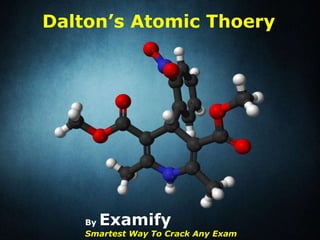
Dalton's Atomic Theory
- 1. Dalton’s Atomic Thoery ByExamify Smartest Way To Crack Any Exam
- 2. Who Is Dalton? John Dalton FRS (6 September 1766 – 27 July 1844) was an English chemist, meteorologist and physicist. He is best known for his pioneering work in the development of modern atomic theory, and his research into colour blindness (sometimes referred to as Daltonism, in his honour).
- 3. What Is DALTON'S ATOMIC THEORY? It was in the early 1800s that John Dalton, an observer of weather and discoverer of color blindness among other things, came up with his atomic theory. The idea of atoms had been proposed much earlier. The ancient Greek philosophers had talked about atoms, but Dalton's theory was different in that it had the weight of careful chemical measurements behind it. It wasn't just a philosophical statement that there are atoms because there must be atoms.
- 4. The postulates of Dalton's atomic theory were used to explain earlier observations of the behaviour of matter. Although two centuries old, Dalton's atomic theory remains valid in modern chemical thought.
- 5. Matter is composed of very tiny or microscopic particles called "Atom".
- 6. Atom is an indivisible particle.
- 7. Atom can neither be created nor it is destroyed.
- 8. Atoms of an element are identical in size, shape, mass and in other properties.
- 9. Atoms of different elements are different in their properties.
- 10. Atoms combine with each other in small whole numbers.
- 11. All chemical reactions are due to combination or separation of atoms.
- 12. With the discovery of sub-atomic particles, e.g., electrons, neutrons and protons, the atom can no longer be considered indivisible. The atoms of same elements are not similar in all respect. They may vary in mass and density. These are known as Isotopes. For example: chlorine has two isotopes having mass numbers 35 a.m.u and 37 a.m.u.
- 13. Atoms of different elements are not different in all respects. Atoms of different elements that have the same atomic mass are called Isobar. Different elements combine in simple whole number ratio to form compounds. This is not seen in complex organic compounds like sugar C12H22O11. The theory fails to explain the existence of Allotropes.
- 14. Presented By Examify www.examify.com
